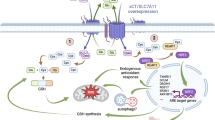Abstract
Midkine (MK), a heparin-binding growth factor, is expressed highly in various malignant tumors, so it acts as attractive therapeutic target. In the present study, we used siRNA targeting MK to downregulate human MK expression in human gastric cancer cell line BGC823 and SGC7901 so as to determine the advantages of this anticancer therapeutic. The cell proliferation was evaluated by a WST-8 (4-[3-(2-methoxy-4-nitrophenyl)-2-(4-nitrophenyl)-2H-5-tetrazolio]-1, 3-benzene disulfonate sodium salt) assay and colony formation assay. Apoptosis was determined by flow cytometer analysis and colorimetric assay. Our results showed that the BGC823 and SGC7901 cell growth were significantly inhibited by knockdown of MK gene. The loss of mitochondrial membrane potential, release of cytochrome c from the mitochondria into cytosol and increased activity of caspase-3, 8 and 9 occurred concomitantly with inhibition of MK gene. These results indicated that siRNA targeting MK gene can inhibit gastric cancer cells growth and induce apoptosis via mitochondrial depolarization and caspase-3 activation. MK siRNA may be a promising novel and potential therapeutic strategy for the treatment of gastric cancers.
Similar content being viewed by others
References
Kadomatsu K., Muramatsu T. (2004) Midkine and pleiotrophin in neural development and cancer. Cancer Lett. 2: 127–143
Muramaki M., Miyake H., Hara I., Kamidono S. (2003) Introduction of midkine gene into human bladder cancer cells enhances their malignant phenotype but increases their sensitivity to antiangiogenic therapy. Clin. Cancer Res. 9: 5152–5160
Tsutsui J., Kadomatsu K., Matsubara S., Nakagawara A., Hamanoue M., et al. (1993) A new family of heparin-binding growth/differentiation factors: increased midkine expression in Wilm’s tumor and other human carcinomas. Cancer Res. 53(6): 1281–1285
Aridome K., Tsutsui J., Takao S., Kadomatsu K., Ozawa M., Aikou T., Muramatsu T. (1995) Increased midkine gene expression in human gastrointestinal cancers. Jpn. J. Cancer Res. 86(7): 655–661
Ikematsu S., Okamoto K., Yoshida Y., et al. (2003) High levels of urinary midkine in various cancer patients. Biochem. Biophys. Res. Commun. 306(2):329–332
Ikematsu S., Yano A., Aridome K., et al. (2000) Serum midkine levels are increased in patients with various types of carcinomas. Br. J. Cancer. 83(6):701–706
Obata Y., Kikuchi S., Lin Y., et al. (2005) Serum midkine concentrations and gastric cancer. Cancer Sci. 96: 54–56
Song X., Muramatsu H., Aridome K., Aikou T., Koide N., Tsuji T., Muramatsu T. (1997) The serum level of midkine, heparin-binding growth factor, as a tumor maker. Biomed. Res. 18: 375–381
Kaifi J.T., Fiegel H.C., Rafnsdottir S.L., et al. (2007) Midkine as a prognostic marker for gastrointestinal stromal tumors. J. Cancer Res. Clin. Oncol. 133:431–435
Huang Y.L., Cao G.C., Wang H., Wang Q.L., Hou Y.Y. (2007) The expression and location of midkine in gastric carcinomas of Chinese patients. Cell Mol. Immunol. 4(2): 135–140
Inoh K., Muramatsu H., Torii S., Ikematsu S., Oda M., Kumai H., Sakuma S., Inui T., Kimura T., Muramatsu T. (2006) Doxorubicin-conjugated anti-midkine monoclonal antibody as a potential anti-tumor drug. Jpn. J. Clin. Oncol. 36: 207–211
Takei Y., Kadomatsu K., Matsuo S., Itoh H., Nakazawa K., Kubota S., Muramatsu T. (2001) Antisense oligodeoxynucleotide targeted to midkine, a heparin-binding growth factor, suppresses tumorigenicity of mouse rectal carcinoma cells. Cancer Res. 61: 8486–8491
Takei Y., Kadomatsu K., Yuasa K., Sato W., Muramatsu T. (2005) Morpholino antisense oligomer targeting human midkine: its application for cancer therapy. Int. J. Cancer 114: 490–497
Banno H., Takei Y., Muramatsu T., Komori K., Kadomatsu K. (2006) Controlled release of small interfering RNA targeting midkine attenuates intimal hyperplasia in vein grafts. J. Vasc. Surg. 44: 633–641
Sato W., Takei Y., Yuzawa Y., Matsuo S., Kadomatsu K., Muramatsu T. (2005) Midkine antisense oligodeoxyribonucleotide inhibits renal damage induced by ischemic reperfusion. Kidney Int. 67: 1330–1339
Dorsett Y., Tuschl T. (2004) siRNAs: application in functional genomics and potential therapeutics. Nat. Rev. Drug Discov. 3: 318–329
Soutschek J., Akinc A., Bramlage B., Charisse K., Constien R., Donoghue M., Elbashir S., Geick A., Hadwiger P., Harborth J., et al. (2004) Therapeutic silencing of an endogenous gene by systemic administration of modified siRNAs. Nature 432: 173–178
Caplen N.J. (2004) Down regulating gene expression: the impact of RNA interference. Gene Ther. 11: 1241–1248
Ishiyama M., Miyazono Y., Sasamoto K., Ohkura Y., Ueno K. (1997) A highly water-soluble disulfonated tetrazolium salt as a chromogenic indicator for NADH as well as cell viability. Talanta 44: 1299–1305
Bai J., Rodriguez A.M., Malendez J.A., Cederbaum A.I. (1999) Overexpression of catalase in cytosolic or mitochondrial compartment protects HepG2 cells against oxidative injury. J. Biol. Chem. 274: 26217–26224
Pathak N., Khandelwal S. (2006) Influence of cadmium on murine thymocytes: potentiation of apoptosis and oxidative stress. Toxicol. Lett. 165: 121–132
Parone P.A., James D., Martinou J.C. (2002) Mitochondria: regulating the inevitable. Biochimie 84: 105–111
Wei H., John J.K. (2003) Anticancer therapy targeting the apoptotic pathway. Lancet Oncol. 4: 721–729
Lisa J.S., John J.R. (2003) Approaches for the sequence-specific knockdown of mRNA. Nat. Biotechnol. 21: 1457–1465
Liu J.J., Lin D.J., Liu P.Q., Huang M., Li X.D., Huang R.W. (2006) Induction of apoptosis and inhibition of cell adhesive and invasive effects by tanshinone IIA in acute promyelocytic leukemia cells in␣vitro. J. Biomed. Sci. 13: 813–823
Mayer B., Oberbauer R. (2003) Mitochondrial regulation of apoptosis. News Physiol. Sci. 18: 89–94
Ohuchida T., Okamoto K., Akahane K., Higure A., Todoroki H., Abe Y., Kikuchi M. (2004) Midkine protects hepatocellular carcinoma cells against TRAIL-mediated apoptosis through down-regulation of caspase-3 activity. Cancer 100: 2430–2436
Acknowledgements
This work was supported by the Scientific Research Foundation of Graduate School of Nanjing University, the Foundation for Key Program of Ministry of Education, China (Grant No. 02111) and the 985-II Program of Nanjing University.
Author information
Authors and Affiliations
Corresponding author
Rights and permissions
About this article
Cite this article
Wang, Q., Huang, Y., Ni, Y. et al. siRNA targeting midkine inhibits gastric cancer cells growth and induces apoptosis involved caspase-3,8,9 activation and mitochondrial depolarization. J Biomed Sci 14, 783–795 (2007). https://doi.org/10.1007/s11373-007-9192-0
Received:
Accepted:
Published:
Issue Date:
DOI: https://doi.org/10.1007/s11373-007-9192-0




